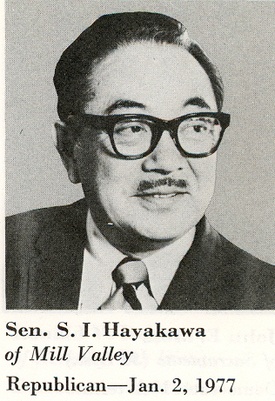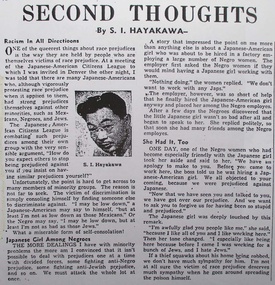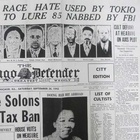Samuel Ichiye Hayakawa and the Chicago Defender
A brilliant scholar of semantics, English professor, poet, historian of Chicago jazz, and U.S. senator, S. I. Hayakawa was the first non-African American to write a series of columns for the Chicago Defender.1 In November 1942, the Defender announced five new columnists and S.I. Hayakawa, who was professor of semantics at the Illinois Institute of Technology at the time, was one of them.2 When he was offered the opportunity to be a weekly columnist, he “accepted, of course, with pleasure”3 but an administrator at IIT said that he “thought it was very damaging and dangerous for any of us to be mixed up with a Negro newspaper, especially for Japanese.”4 Hayakawa was well aware that “there was even a rumor published in the Hearst newspapers that Japanese naval officers had been working in the Negro community to create disloyalty for the United States.”5
But Hayakawa was not concerned with the political risk of speaking out in the Black media. Instead, encouraged by his editor, who said, “What do you think we’re hiring you for if not to say something?”6 Hayakawa wrote his series of columns, “Second Thoughts” in order to “say something.” Even more, “his strong opinions quickly manifest themselves in his columns, and he did not avoid what had been taboo topics for a non-blacks and he did not mince words.”7 He challenged his readers not only through his writing, but through the “creative heterogeneity of his status as Japanese by race, Canadian by nationality, American in essence.”8
Born in Vancouver in 1906, Hayakawa grew up in parts of inland Canada such as Cranbrook, British Columbia, Calgary, and Winnipeg, where the Hayakawas were always the only Japanese family in town. His parents were “internationalists in their twenties, and put their theory into practice by abandoning the insularity of their homeland.”9 He always spoke English with his father, who spoke it perfectly, and talked with his mother “in a home-made language of their own—an absurd mixture of baby-Japanese, literary English and American slang,” in which they expressed themselves differently, but always managed to understand each other.10 Hayakawa was quick to point out that he was never a member of the Japanese Canadian community11 and his parents did not mind the fact that Hayakawa did not possess any signs of Japanese identity.12
With such an isolated upbringing and the superb intellectual gift he was given, it seems that Hayakawa was destined to be an “unabashed assimilationist,”13 to carve “out his own niche in defiance of racial stereotypes”14 and present himself as a “model of what a person of Japanese ancestry can achieve by assimilating.”15 In fact, he once assured a reporter with pride that he did “not know a word of Japanese or want to learn any.”16
Hayakawa visited Chicago for the first time in 1929, on his way to Madison, Wisconsin, where he had been accepted at the University of Wisconsin to pursue a PhD in English with a fellowship and a teaching assistantship.17 On his first night in Chicago, he was met with violence: he went out for a walk before catching his train to Madison and was beaten up and robbed by two Black men.18 Though we have no record of what he thought of the experience at the time, ten years later in 1939, Hayakawa began teaching at the Armour Institute of Technology19 and “became a familiar figure in Chicago’s African American communities because of his passionate love of jazz and of himself as a jazz pianist at café society parties.”20
In October 1942, just before Hayakawa’s first column appeared in the Chicago Defender on November 21st, “Japanese began to be released and allowed to resettle in the East and Mid-East.“21 Ninety-six percent of the Japanese Americans who were leaving the WWII concentration camps and resettling in Chicago from November 21- 30, 1942 were Nisei, with an average age of 25.8, the remaining four percent were Issei, with an average age of 44.5.22 And in fact, resettlers from the concentration camps were encouraged to go to Chicago. For example, it was reported that Ralph Smeltzer, a Christian minister who was born in Chicago and taught at the Manzanar camp, was busily planning to set up a “Japanese Resettlement Hostel” in Chicago to cater to the needs of resettlers as early as December 1942.23 Foreseeing the increased population of Japanese and Japanese Americans in Chicago, could it be possible that the Defender asked Hayakawa to write columns to address this growing minority, and to deal with “enemy” issues concerning the Japanese, specifically for its black readership? Was the invitation to write for the paper “partly [an] expression of solidarity with Nisei”24 from the African American community?
In truth, Hayakawa “refused to speak solely as a Japanese American. Rather, he maintained a stance of objectivity. When he sporadically and reluctantly addressed issues of confinement or anti-Japanese discrimination, he did so within a larger context of promoting American democracy.”25 He was basically an outsider to the Japanese communities wherever he lived whether it was in Canada or in the U.S, and thus could not “always write with a full understanding of the implications of his own background.”26
There was one specific column in which Hayakawa’s objectivity seemed a bit warped and his emotions showed— this essay concerned the New York Japanese artist, Taro Yashima.27 Yashima (born Atsushi Iwamatsu in Kagoshima, Japan ) was an anti-militarist who was involved in the founding of the Japanese Proletarian Artists’ League before coming to the U.S. in 1939. During the war, Yashima worked for the U.S. Office of War Information and later in the Office of Strategic Services, where he offered assistance with the American war effort. Yashima’s propaganda handbills, written in Japanese and illustrated with his drawings, were dropped on battlefields to encourage Japanese soldiers to surrender.
In the article, Hayakawa praised Yashima’s first book, The New Sun, which was published in New York in 1943, as a powerful testimony of the need to defeat Japan and liberate the Japanese. The book exposed Japanese fascism in daily life, which Yashima himself had experienced, which an American audience might not have known about. Hayakawa may have felt some solidarity with Yashima, as a fighter of the same ethnicity, who had “determination to fight back in order to restore what they believe to be (right).” In this way, Hayakawa may have found in Yashima’s life and values a reflection of his own principles for living in a multiracial society: stick to values that go beyond the color line.
Regarding race relations, Hayakawa “returned often to the racialized ignorance of Americans in general,”28 claiming that “most whites in Chicago don’t even know about the amount of discrimination that exists in Chicago hotels, restaurants and places of business…not from a desire to perpetuate injustice, but out of ignorance,”29 noting that there was “anti-Semitism among blacks30 and also among Japanese.”31 Hayakawa did not hesitate to criticize “Japanese Americans who, although vigorously protesting race prejudice when it applied to them, had strong prejudices themselves against other minorities, such as Mexicans, Negroes, and Jews”32 while qualifying that “not enough Negroes and not enough Japanese Americans realize the extent to which they are in the same boat.”33
While “his disregard for his peculiar and particular peripheral status – noncitizen Japanese Canadian – underwrote his opinionated overview of the plights of Japanese Americans and African Americans,”34 he also called the sort of human nature which spread “racism in all directions” a “miserable form of self-consolation!”35 His column for the Chicago Defender, “Second Thoughts,” continued until January 1947.36
From Jitsuzo Harada in the 1910s to S. I. Hayakawa in the 1940s, different kinds of Japanese were interested in and involved with Chicago's African American community over the years, and in their own ways. Did Frank Masuto Kono also have any personal interest in the African American community in Chicago? Looking back at his life in Chicago, it seems that it is very unlikely, almost impossible, that Kono had even the slightest chance to make suspicious contacts with African Americans in Chicago.
Notes:
1. Haslam, Gerald and Janice, In Thought and Action, page 145
2. Doreski, C.K., “Kin in Some Way,” The Black Press, page 165
3. Chicago Defender, November 21, 1942
4. Haslam, pages 131-132
5. Ibid, 132
6. Chicago Defender, November 21, 1942
7. Haslam, page 146
8. Doreski, page 165
9. Hayakawa, “My Japanese Father and I,” Asia, May 1937
10. Hayakawa, “A Japanese-American Goes to Japan,” Asia, April 1937
11. “An Interview with S.I.Hayakawa,” Roots: An Asian American Reader, page 19
12. Hayakawa, “My Japanese Father and I”, Asia, May 1937
13. Haslam, page 143
14. Ibid, page 33
15. Robinson, Greg, The Great Unknown, page 293
16. Chicago Daily News, February 4, 1943
17. Haslam, page 38
18. Ibid
19. Ibid, page 120
20. Robinson, page 292
21. Meyners, J.B., Study of Japanese in Chicago in Relation to Church Organization, page 2, Brethren Historical Library and Archives
22. Ibid, page 4
23. Japanese American Relocation collection, Box 1, Brethren Historical Library and Archives
24. Robinson, page 292
25. Ibid
26. Doreski, page 105
27. Chicago Defender, November 13, 1943
28. Doreski, page 106
29. Chicago Defender, May 22, 1943
30. Chicago Defender, February 13, 1943
31. Chicago Defender, August 12,1944
32. Ibid
33. Chicago Defender, December 16, 1944
34. Doreski, page 175
35. Chicago Defender, August 12, 1944
36. Robinson, page 292
© 2021 Takako Day








